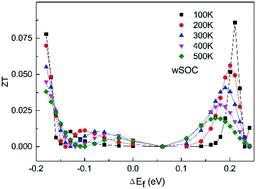Controllable sign reversal of Seebeck coefficient and the large tunability of ZT value of plumbene: a first-principles study
Abstract
We perform first-principles calculations on the thermoelectric performance of high-buckled (HB) plumbene, a new member of the graphene family. We find that spin–orbit coupling (SOC) has nontrivial effects on the thermoelectric properties of HB plumbene. More interestingly, by adjusting the Fermi level to the nearby band edge which corresponds to the van Hove singularity (VHS), the sign of the Seebeck coefficient of HB plumbene can be inverted. Meanwhile, the interdependence relation between conductivity, Seebeck coefficient, and thermal conductivity can be decoupled, and synergistically enhance the ZT value (figure of merit) by two orders of magnitude. With electron doping and hole doping, HB plumbene can have positive and negative Seebeck coefficients, respectively, and the corresponding ZT values can amount to 0.086 and 0.011. In view of the nature of two-dimensional (2D) materials, the Fermi level of HB plumbene can be readily controlled by applying a gate voltage instead of chemical carrier doping. As such, our study provides a feasible platform to control thermoelectric performance in a 2D structure.



 Please wait while we load your content...
Please wait while we load your content...